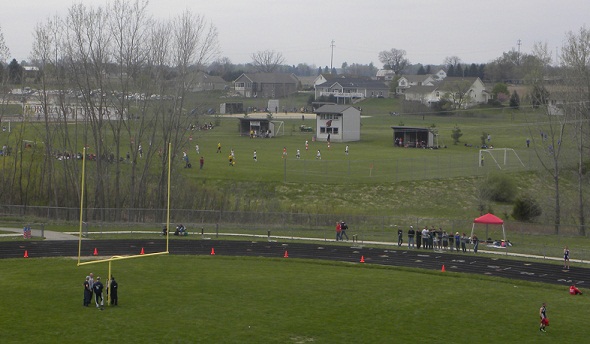
A-PLUS Idea: Portland Spring Carnival
April 25, 2012
A major challenge not just at the high school level, but in athletics as a whole, is the increasing number of competitors for people's time and money.
At Portland High School, local fans get a chance to check out nearly all the Raiders have to offer during a season that rarely draws football or basketball-sized crowds.
A decade ago, athletic director Kevin Veale looked at the unwieldly matrix of dates, times and sports fighting for spectators in his community, and decided to try something. This April 14, Portland hosted its 10th “Spring Sports Carnival."
“Every spring, we have a date when all of our spring sports host home events; except golf, because of its off-campus nature,” Veale said. “It’s a unique event, and from the top of the football press box it’s a pretty awesome scene to view baseball, softball, tennis, soccer and track events taking place at one time.
“Our crowds depend on the weather, of course. But the community has grown well aware of the event, and our local businesses and boosters get behind it,” he added. “We do special concessions, too. One year we barbecued half chickens, and this year it was cheeseburgers, with a lot of the food and supplies donated.”
PHOTO: From the football stadium press box, one simultaneously could watch track, soccer and softball competitions at Portland's Spring Sports Carnival, despite an overcast sky when this photo was taken. (Photo courtesy of Portland High School).

Changes Create Calendar Conundrum
April 2, 2015
By Jack Roberts
MHSAA Executive Director
Decades ago, schools developed policies and procedures for competitive athletics that educators knew were best for both schools and students.
Schools believed that for every sport a period of guided practices to prepare students for competition was important to minimize risks and maximize performance. Maximum numbers of competitions per day and per week reinforced these beliefs and tended to assure students also had time for their studies.
Schools believed that the season should not run on forever, and maximums were established on the total number of weeks and competitions.
Schools believed that at least a short break between sports was good for both the bodies and minds of students, and that an extended break in the summer was also good, providing opportunities to engage in other sports, or for summer employment, or for family time and travel.
On every count, schools were correct.
Unfortunately, over time, sports programs of non-school groups have moved into every month, week, day or half-day that schools have not programmed for students. Most of it is competition without preparation (lots of games, few practices). And parents far too often have been far too willing to pay any amount and drive any distance to facilitate their child’s interest or force their child’s play.
What do educators do when what their heads tell them is the best no longer resonates in the hearts of so many people their schools are to serve?
And that question is at the heart of this week's MHSAA benchmarks series examining out-of-season issues. Watch for more installments over the next four days.

